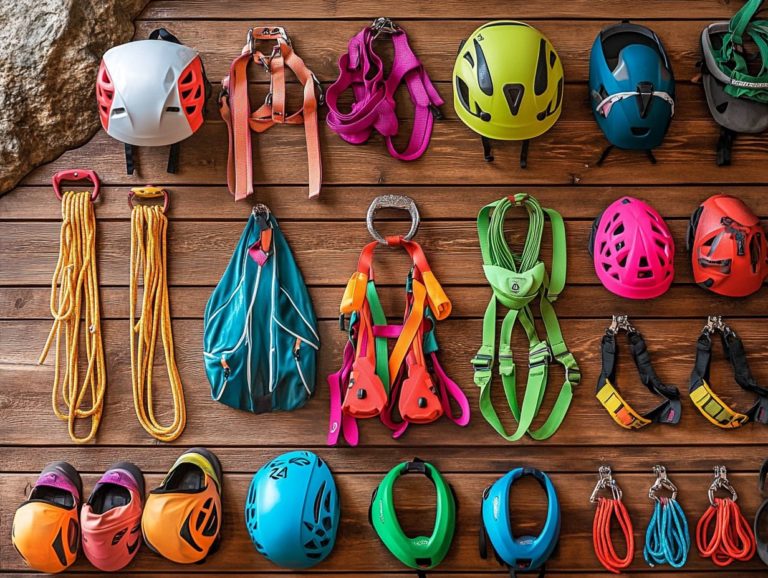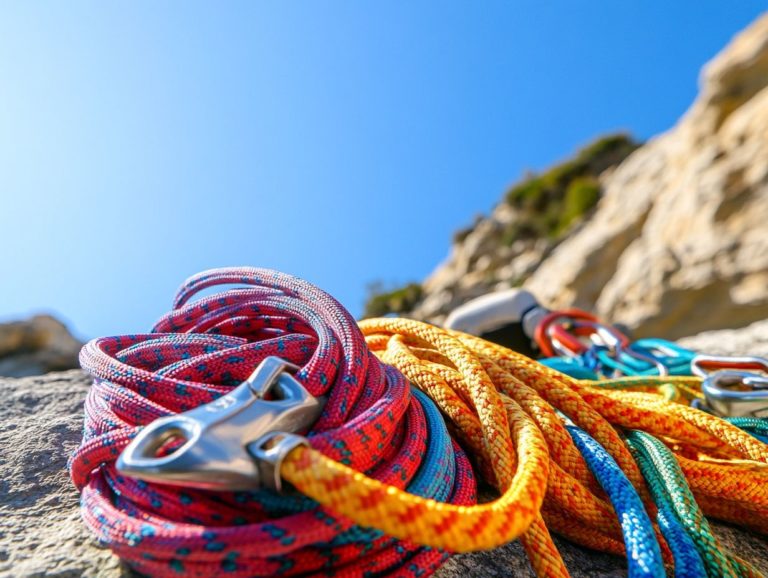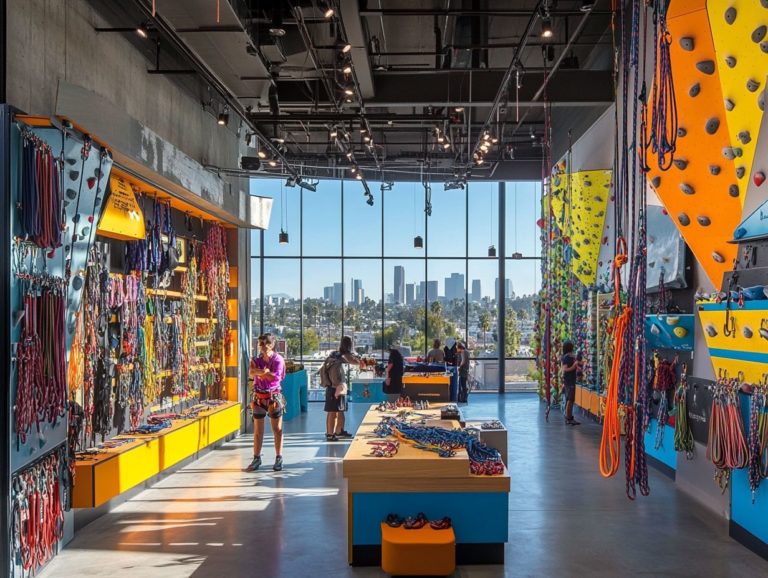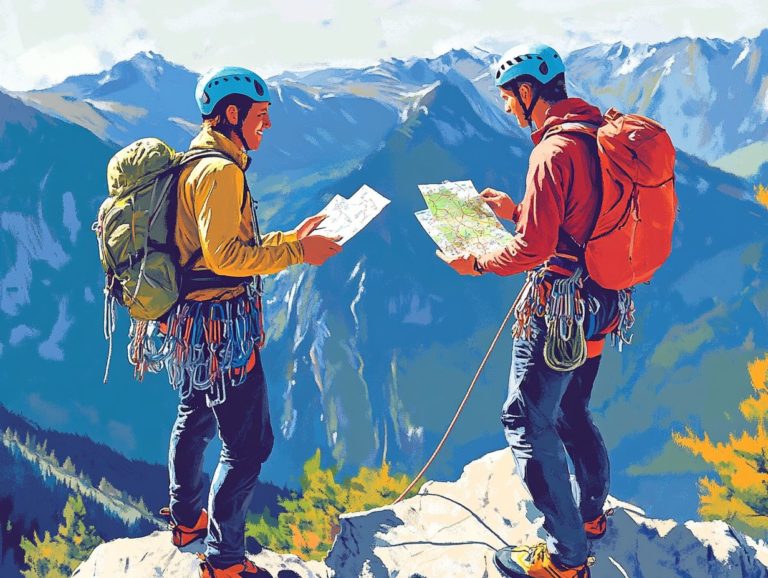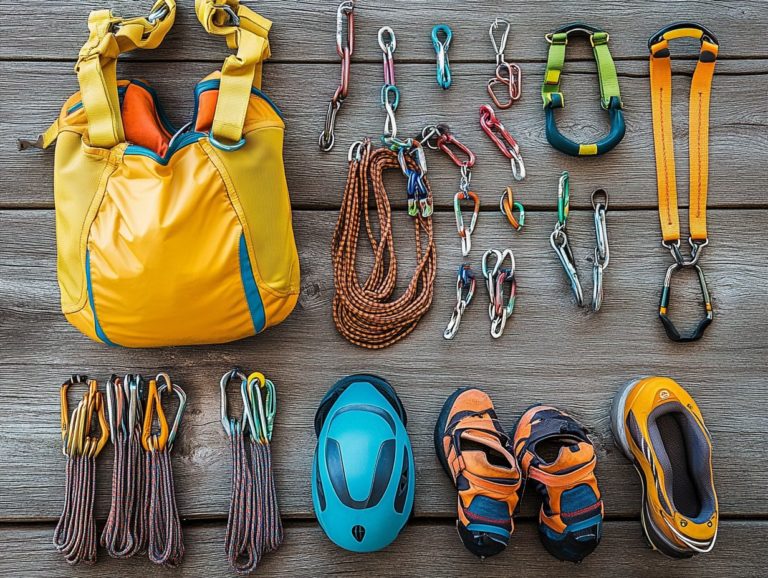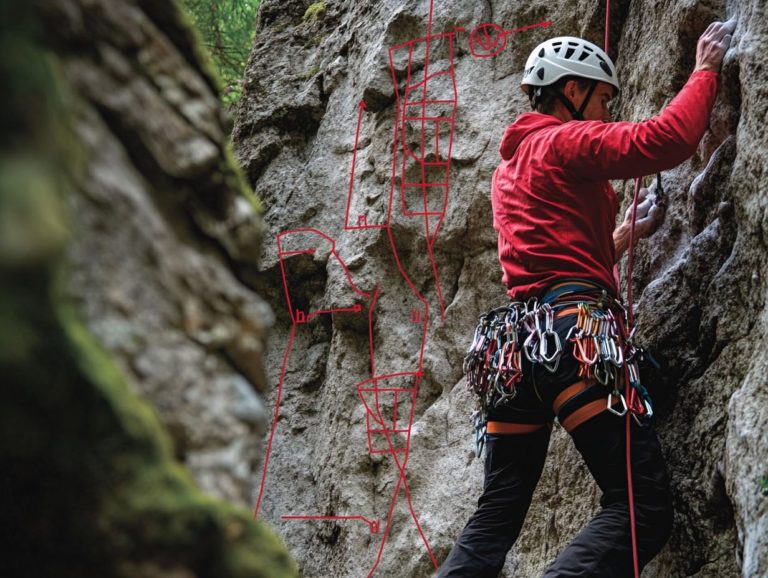How to Properly Clean Your Climbing Gear
Climbing is an exhilarating pursuit. However, maintaining your gear in top condition is crucial for both safety and performance.
This guide highlights the significance of keeping your climbing equipment well-maintained. We will cover various types of gear from ropes and harnesses to carabiners. You ll discover effective cleaning techniques tailored for each item, complete with step-by-step instructions.
You ll find valuable tips on how to store your gear properly. These tips will help extend the lifespan of your equipment.
Ready to take your climbing to the next level? Let’s jump right in!
Contents
- Key Takeaways:
- Why is it Important?
- Types of Climbing Gear
- Ropes
- Cleaning Techniques for Different Gear
- Proper Storage and Maintenance
- Frequently Asked Questions
- What are the basic steps to properly clean my climbing gear?
- Can I use harsh chemicals to clean my climbing gear?
- How often should I clean my climbing gear?
- Should I wash my climbing rope in a washing machine or use another method?
- Can I use a pressure washer to clean my climbing gear?
- Do I need to clean my climbing shoes?
Key Takeaways:
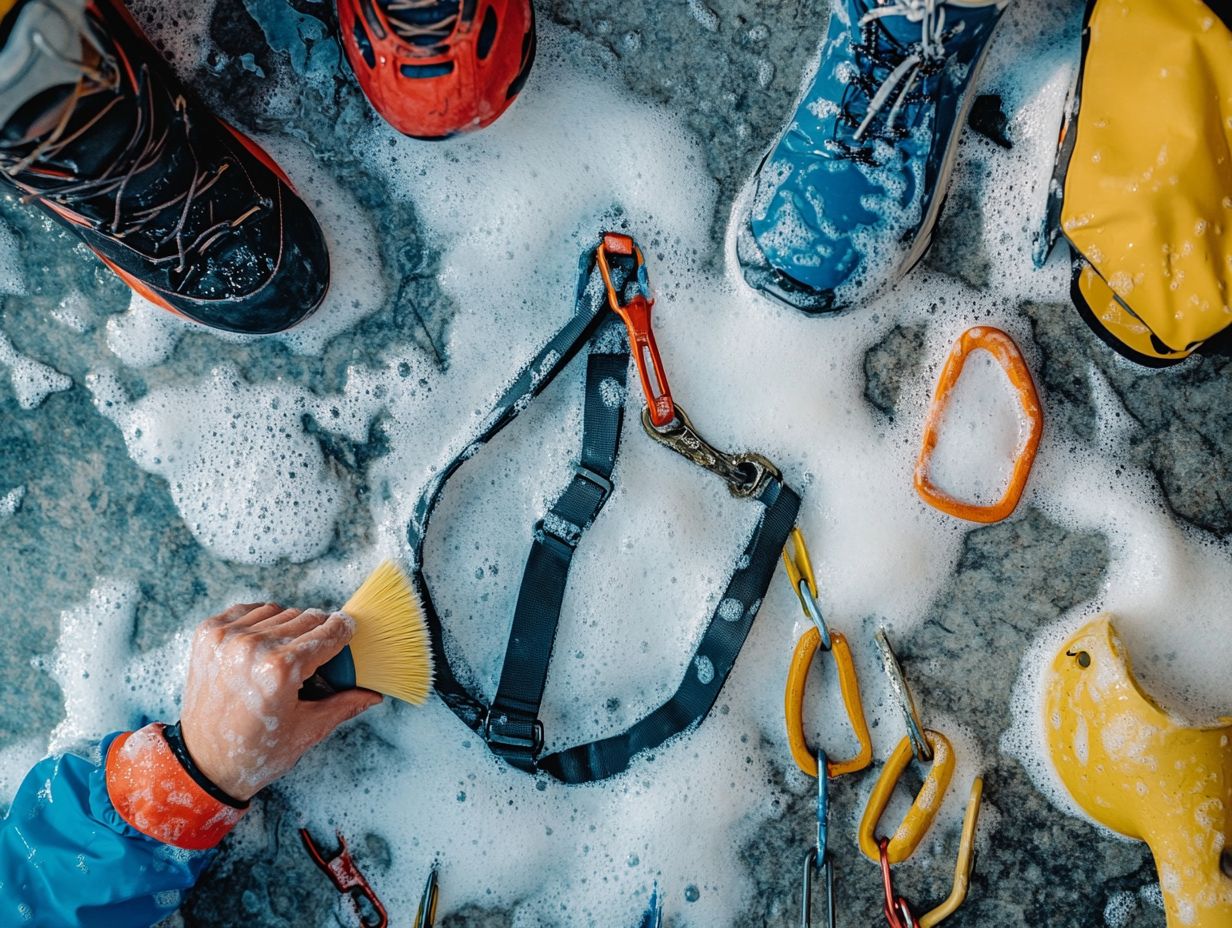
- Clean your climbing gear after each use to prevent dirt and debris buildup, which can compromise safety and effectiveness.
- Use manufacturer-recommended techniques and products to clean each type of gear. For example, brush ropes and hand-wash harnesses. Consider using a rope cleaner for best results.
- Store gear properly by drying it thoroughly before storage and regularly inspecting it for wear and tear. This can extend its lifespan and ensure safety for future use.
Why is it Important?
Keeping your climbing gear well-maintained is crucial. It extends its life and keeps you safe while climbing.
Regular cleaning and maintenance of essential items like harnesses, ropes, carabiners, and climbing shoes are critical to prevent unexpected mishaps. This ensures the longevity of your gear by removing dirt and ensuring proper care.
Understanding when and how to care for your equipment is essential for both novice and experienced climbers. This is especially true when using cleaning products and disinfectants.
Types of Climbing Gear
Climbing gear is a collection of specialized equipment tailored to meet the distinct demands of the sport. This includes vital items like ropes, harnesses, carabiners, and climbing shoes, all designed with safety and performance in mind.
Each piece of gear serves a specific function. It s essential to understand your options, whether you re conquering a rock face or navigating the intricacies of indoor climbing walls. Choosing the right climbing gear not only boosts your performance but also safeguards your well-being during various climbing techniques and activities.
Ropes
Ropes are a crucial part of your climbing gear, providing the safety and support needed during ascents and descents. Choosing the right type of rope is essential for effective climbing. Understanding the different types of climbing ropes dynamic and static will help ensure they perform optimally and safely under pressure.
Dynamic ropes are often the go-to choice for situations that involve significant falls, as they stretch to absorb impact. In contrast, static ropes are ideal for tasks that require minimal stretch, such as rappelling or hauling gear.
Maintaining your ropes is vital for upholding safety standards. Regularly inspect them for frays or damage, wash them with mild detergent and cold water, and ensure they dry properly. Following these practices enhances performance and extends the lifespan of your ropes, making them dependable assets in your climbing toolkit.
Don’t wait! Check your gear today to ensure it’s safe for your next adventure!
Harnesses
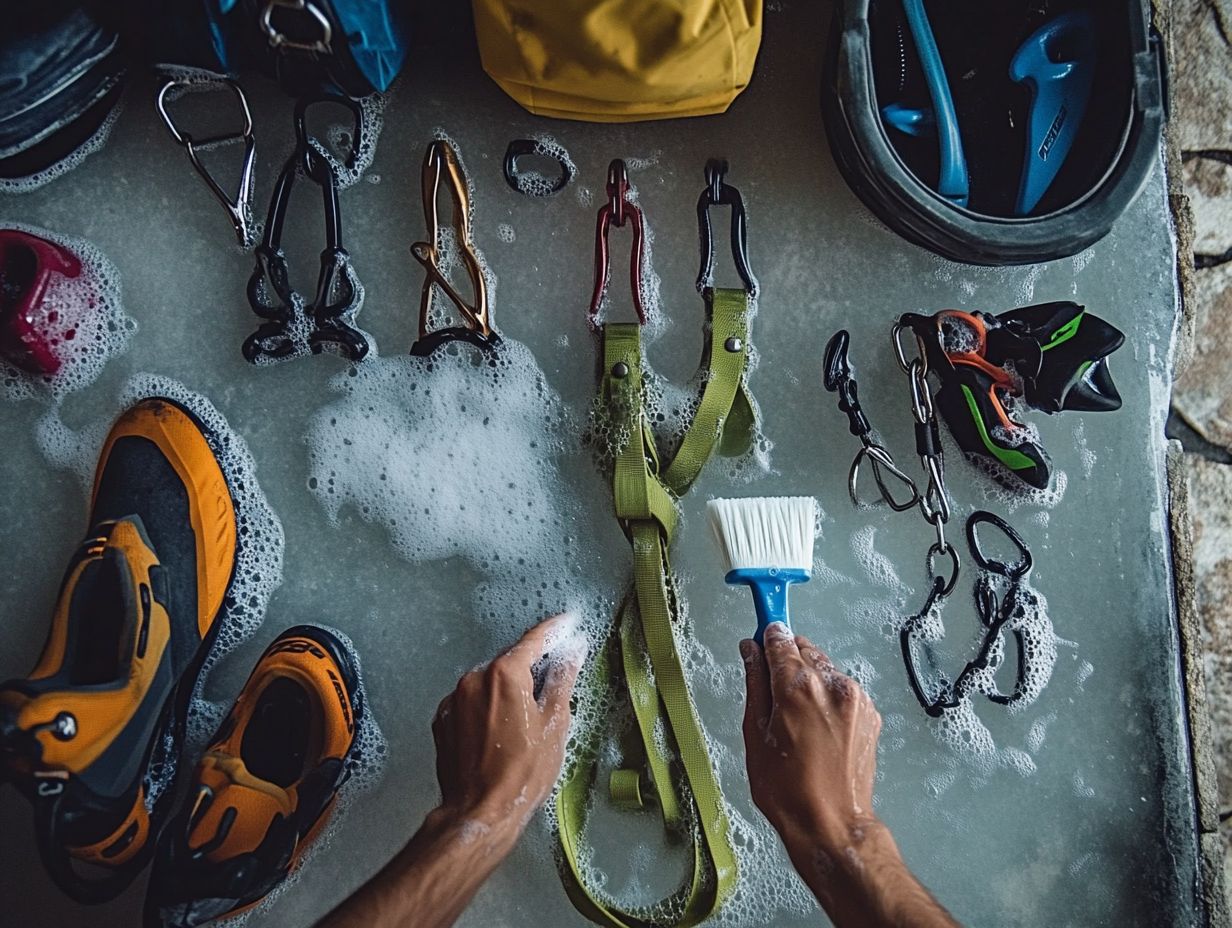
Climbing harnesses are essential for your safety and security. They act as the crucial link between you and the rope system, providing the necessary support during your climbs. Selecting the right harness and committing to regular maintenance and inspection are key to ensuring your comfort and safety in all climbing endeavors.
There are various types of harnesses recreational, sport, and mountaineering. Each serves a unique purpose designed for different types of climbing. For example, a sport harness is crafted for lightweight flexibility, perfect for those quick ascents. In contrast, a mountaineering harness comes with extra padding, making it ideal for extended adventures where comfort is paramount.
Regular inspections are crucial for prolonging the life of your harness. This helps you avoid accidents from wear and tear. Be sure to check for frays, damaged buckles, or any signs of degradation. Keeping your gear reliable is vital as you ascend.
Carabiners
Carabiners are essential connectors in your climbing gear. They serve as the vital link between various pieces of equipment, playing a significant role in ensuring both safety and efficiency in your climbing techniques. Choosing the right type of carabiner and maintaining it properly is crucial for a secure climbing experience.
There are a wide array of designs available locking, non-locking, and specialty carabiners. It’s important to understand the advantages and applications of each type. For instance, locking carabiners provide an extra layer of security by preventing accidental openings. This makes them perfect for belays and anchors.
Don t wait! Regularly check for wear and tear and keep them clean to ensure durability and performance. By adopting a systematic approach to safety checks before and after each use, you can immerse yourself in the adventure without compromising your well-being.
Other Gear
In addition to ropes, harnesses, and carabiners, a variety of climbing gear, such as climbing shoes, pads, and backpacks, plays a crucial role in enhancing both your performance and comfort during climbs. Whether you’re bouldering or tackling multi-pitch routes, understanding how each piece of equipment contributes to your overall climbing experience is vital.
Don’t overlook the importance of other essential gear, like belay devices, which expertly manage rope tension and braking to ensure your safety while climbing. Chalk bags keep your hands dry and maintain grip, while climbing helmets protect you from falling rocks and other hazards. You might also want to consider specialized climbing gloves for extra grip and protection, giving you better control on those challenging routes.
If you re venturing into the backcountry, investing in a reliable climbing backpack is essential. It allows you to carry your gear efficiently and comfortably, letting you focus on the ascent without the distraction of cumbersome equipment.
Cleaning Techniques for Different Gear
Using the right cleaning techniques for various types of climbing gear is essential for ensuring both safety and performance. Each material requires a specific approach for effective maintenance.
For instance, you might toss your nylon gear in the washing machine, while your climbing shoes deserve a gentle hand wash with mild detergent. By mastering the best practices for cleaning each piece of equipment, you’ll not only extend its lifespan but also maintain peak functionality during your climbs. Additionally, understanding the importance of climbing gear inspection is crucial for safe and effective use.
Step-by-Step Instructions
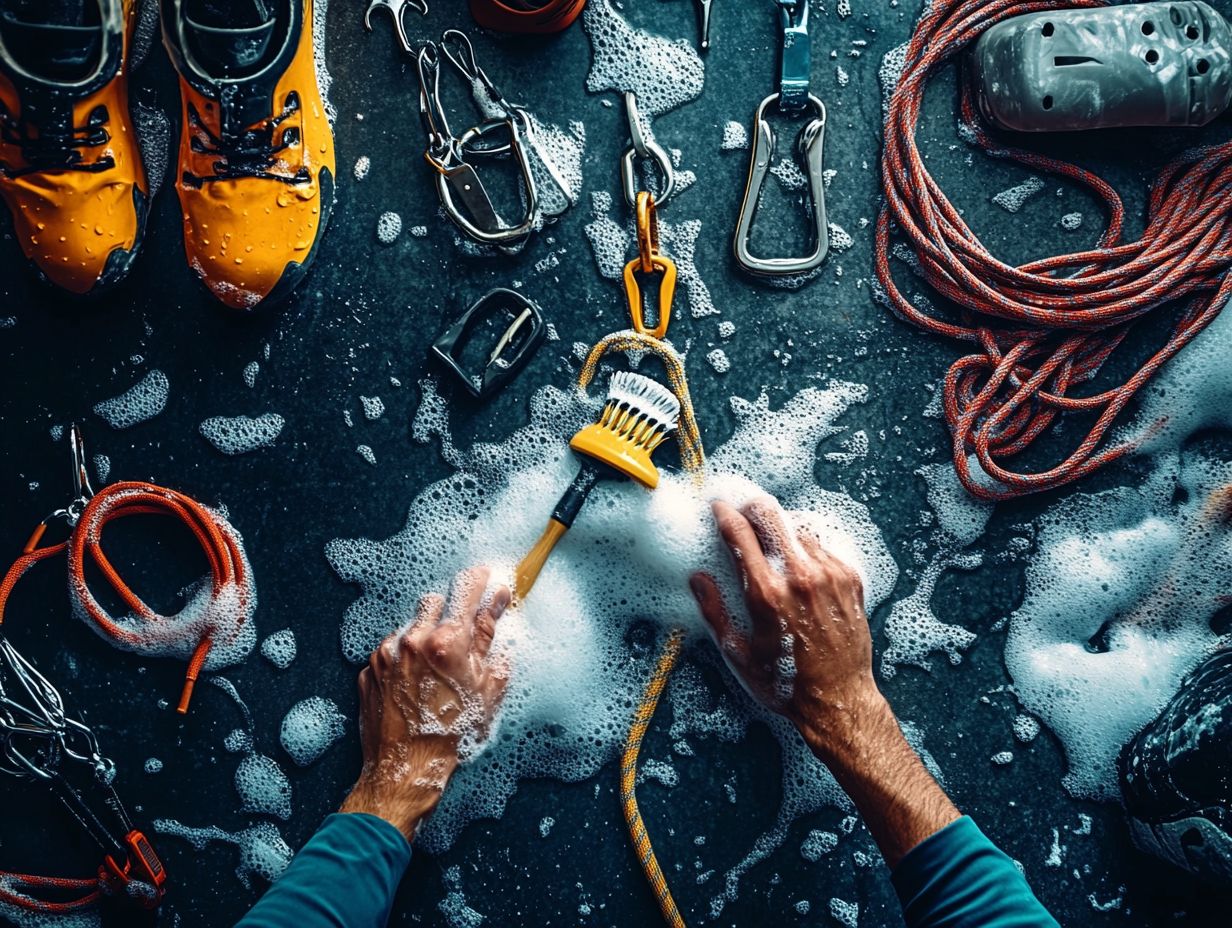
A meticulous cleaning process for your climbing gear enhances its how long it lasts and performance. This ensures you uphold safety standards essential for your climbing adventures.
By following detailed instructions tailored for each type of equipment, you can clean your gear with confidence, knowing it s primed for your next ascent.
From ropes and harnesses to carabiners and helmets, each piece of gear has specific care requirements. When properly addressed, these will optimize both performance and safety.
Ropes should be washed gently to eliminate dirt and chalk, using a mild detergent. Avoid harsh chemicals that could compromise the fibers. Harnesses thrive on a mild soap wash, ensuring they re rinsed thoroughly to avoid any residue that might lead to slippage in critical moments.
For carabiners, a quick wipe-down followed by lubrication on the moving parts will keep them operating smoothly. By familiarizing yourself with these cleaning processes and following the top tips for caring for your climbing gear, you not only protect your investment but also ensure your gear is reliable when it matters most.
Proper Storage and Maintenance
Proper storage and maintenance of your climbing gear are crucial for ensuring its longevity and optimal performance, especially after cleaning. Adhere to best practices for storing ropes, harnesses, and other equipment.
Doing so safeguards your gear from damage while preserving the functionality and safety features essential for a successful climb.
Tips for Prolonging the Lifespan of Your Gear
Want to make your climbing gear last longer? Here s how! Embrace effective maintenance habits, including regular cleaning, thorough inspections, and proper storage techniques. Following these essential practices will ensure your equipment stays in peak condition, ready for your next adventure at a moment’s notice.
Make it a habit to inspect your harnesses, ropes, and carabiners before and after each climbing session. Look for any signs of wear or damage like fraying ropes or cracked carabiners that could jeopardize your safety.
Cleaning is just as vital. Use mild soap and water to wash gear that has come into contact with dirt, sweat, or saltwater. Ensure everything dries completely before you store it away.
For storage, select a cool, dry place, avoiding direct sunlight and extreme temperatures, as these can gradually degrade the materials.
By adopting these practices, you maximize the performance of your gear and elevate your overall climbing experience.
Frequently Asked Questions
What are the basic steps to properly clean my climbing gear?
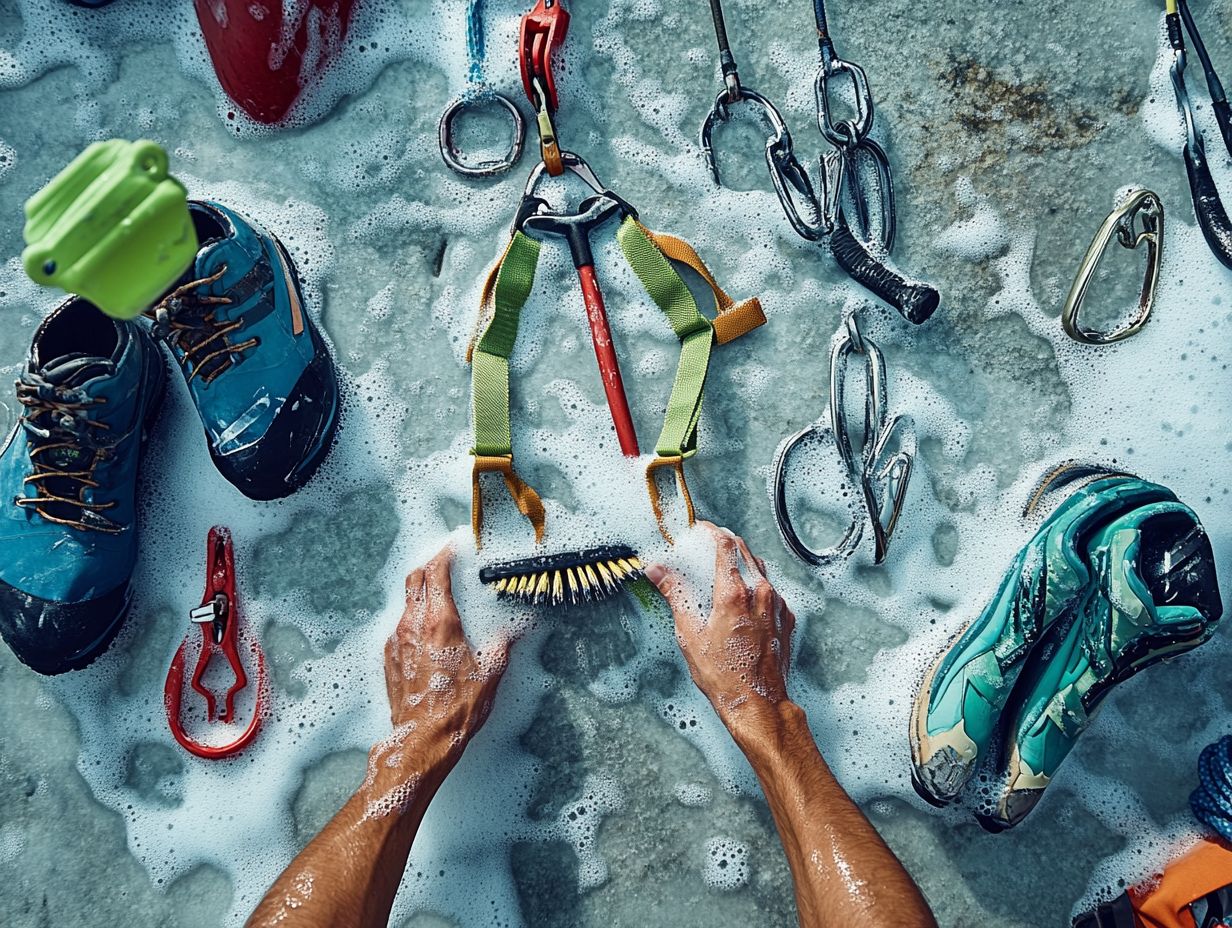
To properly clean your climbing gear, follow these steps:
- Remove all dirt and debris from the gear using a soft brush or cloth.
- Wash the gear with a mild soap and warm water.
- Rinse thoroughly with clean water and allow it to air dry completely.
- Inspect the gear for any damage or wear and tear. Replace if necessary.
- Store the gear in a cool, dry place away from direct sunlight.
Can I use harsh chemicals to clean my climbing gear?
No, it is not recommended to use harsh chemicals or solvents to clean your climbing gear. These can damage the materials and compromise its strength and safety.
How often should I clean my climbing gear?
You should clean your climbing gear after every use or at least once a month, depending on how often you use it. This will help maintain its quality and prolong its lifespan.
Should I wash my climbing rope in a washing machine or use another method?
No, you should never wash your climbing rope in a washing machine. The agitation and heat can damage the rope and compromise its strength. Hand washing is the preferred method.
Can I use a pressure washer to clean my climbing gear?
No, pressure washers should never be used to clean climbing gear. The high pressure can damage the materials and weaken the gear, making it unsafe to use.
Do I need to clean my climbing shoes?
Yes! Cleaning your climbing shoes is essential for maintaining their grip and performance.
Regularly removing dirt, sweat, and oils will keep them in top shape.
Use gentle soap and water for cleaning.
Then, let them air dry completely before your next climb!

